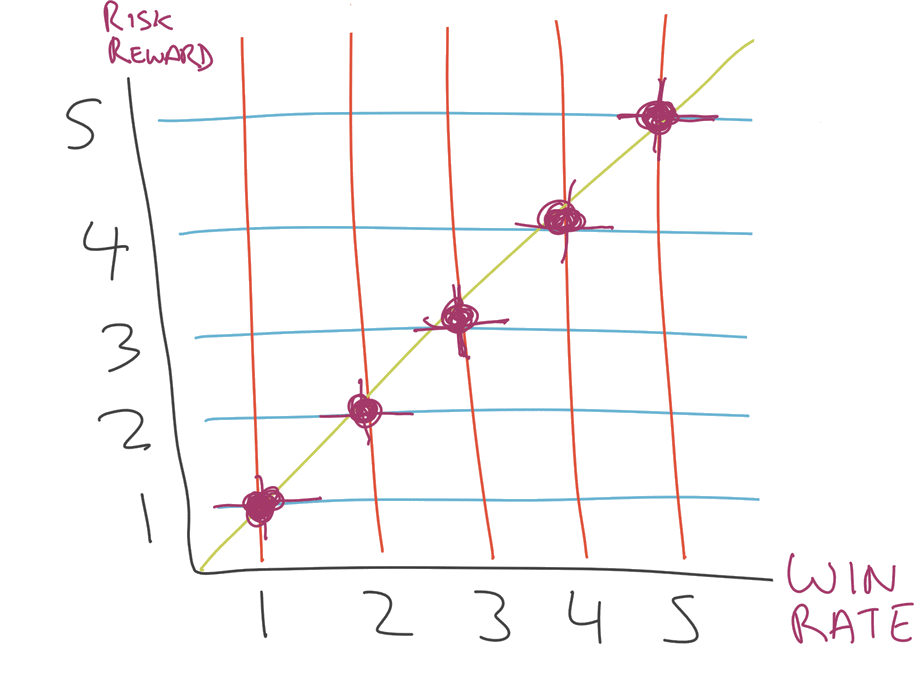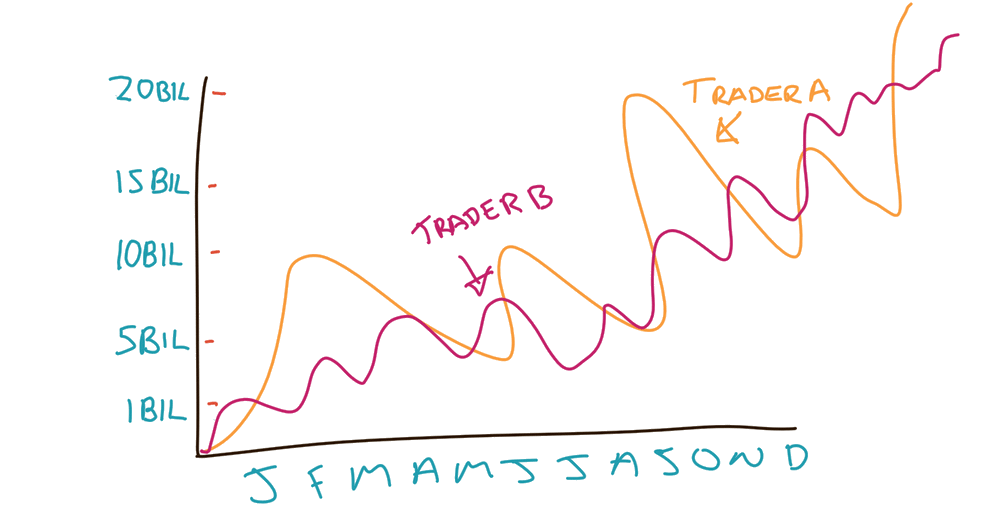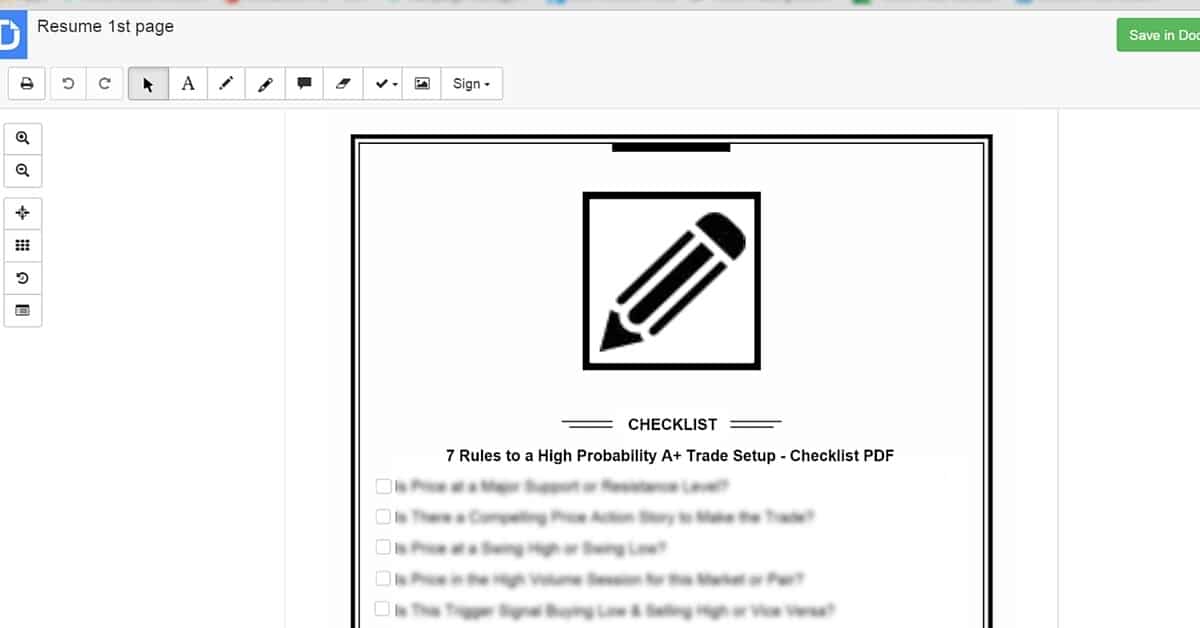Do you know what you are?
You cannot be both, and be profitable and successful.
You must choose one method and consistently, with discipline, stick to that strategy. What on earth am I muttering about?
In this lesson, I am going to take you through exactly what the differences are between the trader who makes trades looking for high risk reward, for example, 3:1 or more each trade but has a smaller win rate, and the trader who aims to have a high win rate and only needs to take smaller profits each trade but takes those profits regularly and consistently.
There are MAJOR differences between these methods that not only can have huge effects on the outcome of how their account moves but also the psychology of you the trader, depending on which method you use and how you are prepared.
NOTE: I know there are a lot of traders who read this blog and are not sure what money management is. If you do not change the size of your trade every single trade, or if you do not use a position size calculator to work out how big your trade should be, then before even considering reading this lesson, you need to first rewind and go read this lesson here:
Money Management That Really Works
Ask Yourself These Questions…
There are two very basic methods or strategies when it comes to managing your trades, both with severely different outcomes for your account balance and trading psychology.
Let me get something straight before I get started; one method is not necessarily better than the other. Both methods have huge positives, but they also both have their negatives which I will take you through.
As I go through this lesson, I want you to be thinking about your trading, trade management, and how you would normally manage your trades. If you are profitable, is there anyway you can improve? If you are not yet profitable, could you look at testing the other trade management method? Or could you tweak the method you are using at the moment?
A question you really do need to ask yourself is,
“Is the trade management method you currently use very psychologically demanding and making it hard for you to be profitable?”
These are the types of questions I want you to ask yourself as you go through this lesson.
Trade Management Explained
The major difference between the two trade management methods is that trade management method A is a High Reward and trade management method B is High Win Rate.
What does this all mean when it comes down to it? Traders who use method A are making trades that have a big risk reward; in other words; they are looking for big winners. The major problem with this is that common sense and law of averages say that the bigger the risk reward you aim for, the more you are going to lose. This is simple math just as the chart below shows with my awesome illustration!
Obviously in the real trading wold things do not work out perfectly or 1 for 1 like in the chart below and obviously the chart is just for highlighting an example to show that as you make more rewards the chances are that you are going to make more and more losses.

This is okay as long as the trader who aims for the big risk reward trades makes profits overall. The aim of the game/business is profits, so as long as profits are being made, then all is fine.
Psychologically, it can get really tough on the trader when they start moving higher up in their account, and the account starts growing and getting larger. The trader starts to risk more and more money, and, as just explained, the trader is going to make a lot of losses, even if they are profitable.
This can mean that their trading account can often move in wild swings. They can make quite a few losses in a row whilst they wait for the next big winning trade or winning run to make them profitable again.
As you could imagine; this type of trading could be hard if you are not mentally strong and ready for it. It could especially be hard if you are trading large sums of money, rather than just pennies, and you are watching those large sums have wild fluctuations on more than one occasion. But, this is how you trade so it is a part of everyday trading life.
At the end of the week, month, and year, all that matters is the profits. However, if a trader is under a lot of strain, then they will find it super hard to make any profits because the decisions they make will be severely impacted.
The trader who is using method B is pretty much doing the complete opposite. This trader is not looking for the big winners. Instead, this trader is looking for the smaller, but consistent and regular, gains.
Once again my stellar illustrations come to the rescue and highlight the major difference between the two traders in the drawing below; See how trader A has an equity curve that is prone to have the odd wild up and down? Whilst trader B has an equity curve that is a lot more steady. This is even though they both end up at the same point.

This trader is trying to avoid the wild account equity swings by building an equity curve that is continually rising through taking profits. I can hear a lot of you saying, “Oh gee wiz, that sounds great, so what is the down side?”
Because this trader is regularly taking profits, they are not getting the huge winners like the other trader is getting. This means that when they get stopped out, it hurts them a lot more than the big risk reward trader who is making 4/1 RR winners.
Obviously, a 1/1 risk reward winner is going to be wiped out by just one loss. In other words, this means a trade that makes a profit of 1 x risk could have all that profit wiped out by just one losing trade.
The trader who is making 4-1 risk reward winners, obviously, could afford to lose 4 trades before they are back at break even. The trader taking regular and consistent profits often does not have this luxury.
This is DEFINITELY something that high win rate traders need to keep in mind, and it is one of the downsides of their methods. As I said, it is not all ‘cookies & cream’ here for either method.
Because this trader is taking far more regular profits and because their win rate is a lot more steady, it means their equity curve is a heck of a lot more stable rather than the wild curve of trader A, as the graph shows above. This makes it a lot easier psychologically to consistently make profits time and time again, especially when the stakes begin to increase and you move your account into the big time.
So What Method to Use?
As I alluded to at the start of this lesson, there is not ONE method that is better than the other. I have been really careful during this lesson to not try and sway you either way because I want you to be profitable, and the best way for that to happen is for you to be paired with a trade management method that is closely aligned with your comfort levels and personality.
Some traders are far better suited to the high reward because their personalities just mash with it better, and others gell better with method B where they can increase their equity curve consistently overtime.
The best way for you to work it out is to quickly download my super quick cheat sheet which will take you two minutes to go through, and it will help you ask yourself the questions you need to ask to work out what is the best method for you and your individual personality.
My Personal Trade Management Method
For a long time now I have lived by the Mark Douglas rule of consistent trading that states,
Obviously, there is a line with this, and a trader cannot just open a trade with a 100 pips stop and take profit at 10 pips every trade because Mark Douglas stated you need to pay yourself as the market makes it available.
The aim of the trading business is profits and as much profits AS POSSIBLE. The way I make as much profit as possible is by taking profits as the markets make it available to me, but trying to cash in and look for the bigger risk reward trades when I am trading with the trend.
I trade each market differently, and as members of the price action course know, trade management is super important. I temper and tailor my trade management to individual market types. How I take profits depends on the market type.
I may look for bigger risk rewards and manage a trade looking for bigger profits, or I will manage strictely depending on the market type and my trading plan rules that are set out in my plan and trading checklist.
I hope this has made it really clear to you. You should be starting to get a picture and feel for the type of trader that you are and the type of trader you want to become. DON’T WORRY if you are not 100% sure what trader you are or if in the past you have been all over the place trying to be both traders!
That’s exactly what this lesson is for. You now need to go and take action because obviously NOTHING happens, and no one improves or makes any changes without making huge action in their lives.
That’s why all my lessons from now on have either action or homework points for you to go through. And they are not just fluff like go and pat and bunny rabbit, they are action points and homework that are going to make huge improvements when you follow them.
Your two homework action points for today:
- Download the Cheat Sheet “Are You High Risk or High Win Trader”?”
- Go into the comments below, and answer the question that I would love to know, “What is your trade management method or strategy?”
All the success with implementing these lessons, and if you need any help with anything learned in today’s lesson, either just post your questions below in the comments.
Safe trading,
Johnathon



Here is a strategy I have been following for some time now. It’s not always perfect, but it seems to work quite well. I mainly trade the Daily, but I will look to the 4H and 1H for a better entry (higher Reward:Risk basically). So when I place my trade, I will often split the trade in 2 parts where part 1 I will take book at 1R and part 2 will then move to BE as my free trade. I move my stops first on the 4H swings and then look to the Daily once part 2 is at BE in order to see how far I can let that one run. Sometimes, depending on how the market moves, I might even have part 1 go past 1R and it does not come back to the 1R target on the pullback, so I will do the same with that one as part2…. Hope that makes sense?